
1. Introduction
Customer satisfaction and loyalty depend on thorough testing. A software program that has undergone thorough software testing is less likely to have defects or bugs that may negatively impact the user experience. Bugs that get it into production are more likely to be seen and criticized by users as the number of the product’s end users grows.
At this point, stakeholders need to begin assembling and overseeing a QA team. The QA process typically begins with the recruitment of an experienced QA tester and the formation of a dedicated software testing company. In order to help with this step, this article explains best practices of establishing a QA testing process that works for your business and meets all of your needs and goals.
2. What is QA Process?
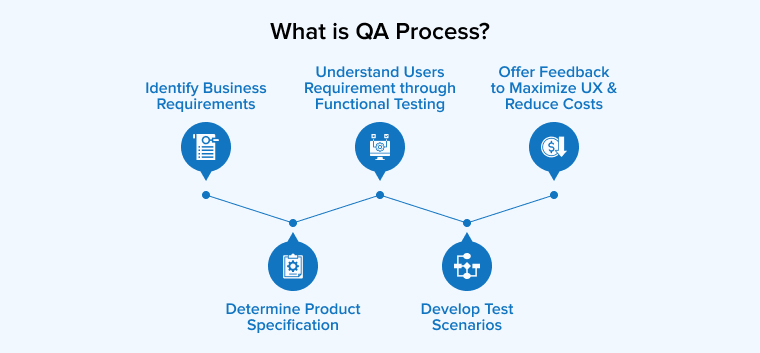
Quality Assurance is one of the most important software testing processes that enables the testing team to ensure that the product created by the developers is built as per the client’s requirements and without too many iterations. The QA process starts at the early stages of the software development lifecycle. Besides this, a proper QA process clearly defines the system requirements, gives QA engineers a thorough understanding of the systems’ functionalities & features, and offers the testers a blueprint for the system’s progress. This means that testing is a process that must not follow software development process but should support it as testing activities that occur parallelly can help in keeping the software in check. All these things prove that implementing the QA process while developing software can help in getting better outcomes.
3. Why Should QA Processes be Implemented?
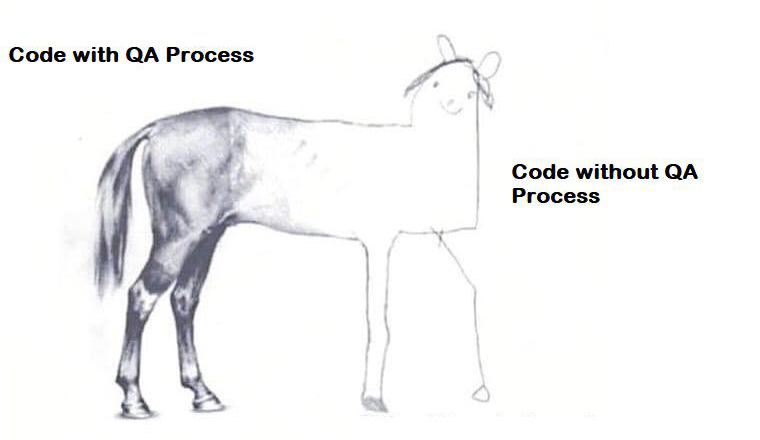
- Introducing a standardized QA process may have a profound effect on the success of your company.
- The improved quality of your products will lead to more satisfied and devoted buyers.
- The QA engineer can put their efforts towards developing and releasing new features and enhancing existing ones.
- When customers are happy, they are less likely to file complaints, or they may not file any at all.
- The likelihood of a failed product is reduced when it is of a high grade.
- Since avoiding problems is less expensive than resolving them later, a good QA process will help bring down the project’s overall cost.
4. Challenges of QA Process
It’s not always plain sailing during quality control. As the foundation of quality assurance, software testing is crucial to delivering high-quality software. The primary difficulties in implementing QA process are as follows:
4.1 Specificity is needed
For any product or service to succeed, you must first develop its requirements. There are many different kinds of software testing, and you should be familiar with the distinctions between them and how to pick the one that is best appropriate for your needs.
After completing the QA process, you may be assured that your product meets all of your specifications and the expectations of your target market.
4.2 Testing is laborious
The lengthy nature of the QA process is one of its major drawbacks. Even with automated tests, testing might be the most time-consuming part, particularly if new test cases and scripts need to be written from the start. Since your product will need to be tested and modified often, the final result may take more time to achieve than initially anticipated. Hiring QA professionals and a dedicated project manager can aid in improving your testing approach and fighting this.
4.3 Uncertain anticipations
Stakeholders, including customers, should be kept in the loop by the project team at all times. Unrealistic outcomes are possible without a well-defined project goal. Lack of communication on the part of the QA engineer team might lead to misunderstandings about how the test scripts relate to the overall goals. It would be counterproductive to provide a polished final product that falls short of stakeholders’ expectations.
4.4 Automation tools
Automated testing is the primary automation technology that may be used throughout of software development life cycle. To make the most of automation tools, your software development team will require personnel with relevant experience and expertise. You should also know where automation shines so you don’t overuse it and lose out on manual testing’s advantages.
5. Stages of QA Process
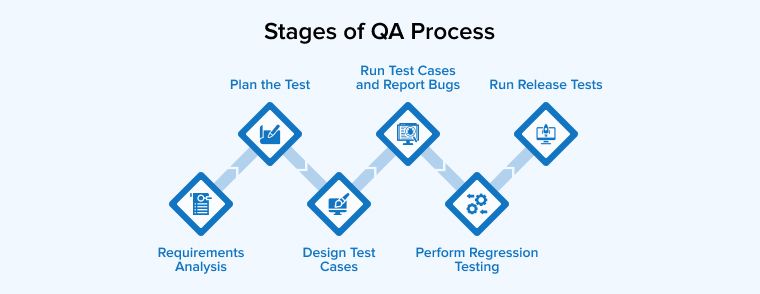
5.1 Requirements Analysis
Fixing a problem found in testing is more expensive than preventing it during requirements design. QA professionals should be involved in assessing and defining software requirements, both functional testing and non-functional testing. Quality assurances need to be indicated by regular, thorough, and traceable criteria. The QA team may then use this information to create tests that are relevant to the target application.
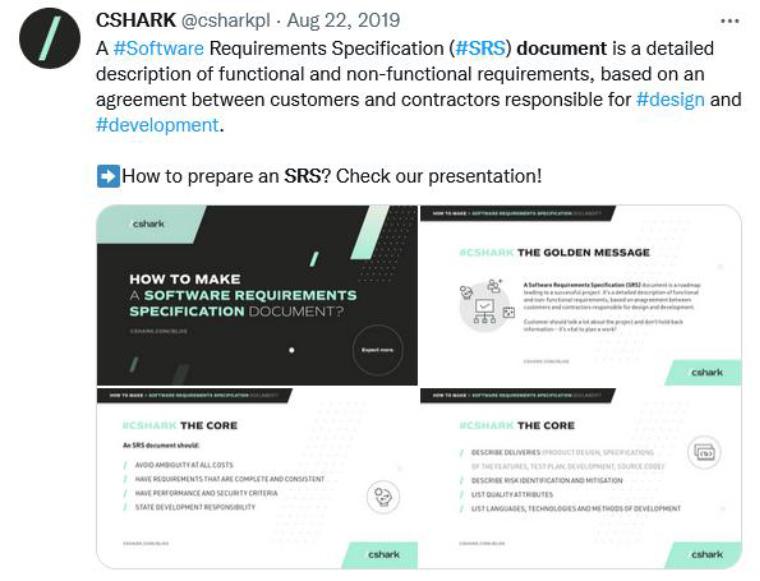
The next step to this is planning for software testing.
5.2 Plan the Test
After analyzing the requirements for the quality assurance process, it is now time to plan the testing process. For this, there are some specific steps that must be taken by the testing team that we are going to discuss in this section.
When you are executing a plan for your application that will undergo testing, there are a few serious aspects that need to be kept in mind before implementation. You need to develop a test strategy in order to proceed ahead in this QA process.
The expectations from the testers are to develop a test strategy that not only allows them to test the software more thoroughly but also gives all stakeholders confidence in the product’s quality. The most important component of this phase is to develop a plan. During implementation, the developing software product should be error-free, long-lasting, and well-liked by its customers.
There are different types of tests that can be performed in different test environments. The QA team will take all the test data into the account and ensure a seamless testing method initiates. The testing types are unit testing, system testing, user acceptance testing, performance testing, security testing, integration testing, smoke testing, regression testing, load testing, cross-platform testing, and more. Each one can be performed in a unique staging environment.
5.3 Design Test Cases
The next step is to design the test cases. QA experts will create test cases and checklists that cover software requirements at this level. Each of these test cases will provide the circumstances, test data, and test methods required to validate specific functionality as well as the desired test outcome. Test engineers may begin test design operations with a certain amount of data in order to establish acquaintance with an application and come up with the best testing strategy to test design. Team members can write test documentation during this phase to ensure the test planning goes in the right direction. The QA team members can define software quality metrics here.
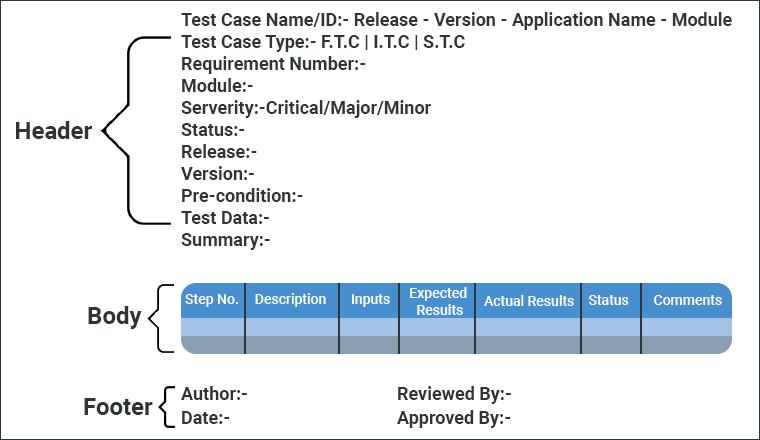
The quality assurance process ensures to meet all the needs and perform all the required tests. This can have two types of testing- Manual Testing and Automated Testing.
In manual tests, all the test scenarios take place manually. Test automation engineers generate test automation scenarios throughout the test design stage when test automation is in scope. In addition, the test environment is set up for the test execution. In terms of hardware, software, and network configurations, operating system settings, accessible databases, project documentation, and other features, the test environment should closely resemble the production environment.
5.4 Run Test Cases and Report Bugs
In this process, developers perform Unit tests at the beginning of the testing process. There is a bug tracking system designed by a QA engineer for each test case execution. This will streamline the bugs management and tracing will get easier. This will allow users to apply tests in each section and the end results received will manage the overall quality control of your apps.
Every team member and test manager will perform different necessary testing activities.

Once every team member has performed their respective test programs, rerun the test cases to double-check if all the tests bring the expected outcome or not. If not, report the bugs and resolve them.
The QA team will then conduct testing at the API and UI levels. You can carry out manual testing process in line with test cases with readily available specifications. All the discovered flaws will go through exploratory testing and get into a defect tracking system. Additionally, test automation engineers may run test scripts and create test reports using an automated test framework like Selenium or Appium.
5.5 Perform Regression Testing
Now the next phase is to perform regression testing. When you identify the defects, it’s now time to repair and resolve them. QA engineers will perform regression tests to ensure that everything is working correctly and that the new changes have not changed anything. You can repeat this whenever you implement any new features.
The regression test’s primary goal is to find faults or flaws in the product. One of the most important aspects of the testing activities is the testing team’s and the project development team’s tracking of flaws and faults for the project development.
Regression testing is a process that retests all the functions of the project, tests the sections, and priotize the test cases which can help test the project very efficiently.

The QA processes are critical because they indicate areas where development and testing might be improved. This means the expected test result is better than what’s assumed.
Full regression testing becomes time-consuming in Agile projects as the number of times a regression test suite is run grows. Test teams may mix partial and complete regression testing, prioritize regression testing operations based on defect risk levels, and automate a regression test suite to enhance the regression testing process.
5.6 Run Release Tests
This is the last stage of a well-established QA process where bugs will be detected by applying various quality metrics. There is a specific QA flow involved in every QA process. But, why is release testing a part of QA activities? This answer should be known.
The term release testing has a set of coding techniques and test methodologies just like other testing methods. This test ensures a software release that is suitable for all users. The goal of release testing is to detect and fix faults and flaws in a software release before it is made available to the public. It meets all the testing goals and fixes the bugs from a unit level before the actual users use it. The test case which was not addressed during bug tracking will be addressed by QA specialists at this phase now.
After this, you can claim that the software quality standards are met and the developed software can now be used by consumers in the market.
6. Tools for QA Process
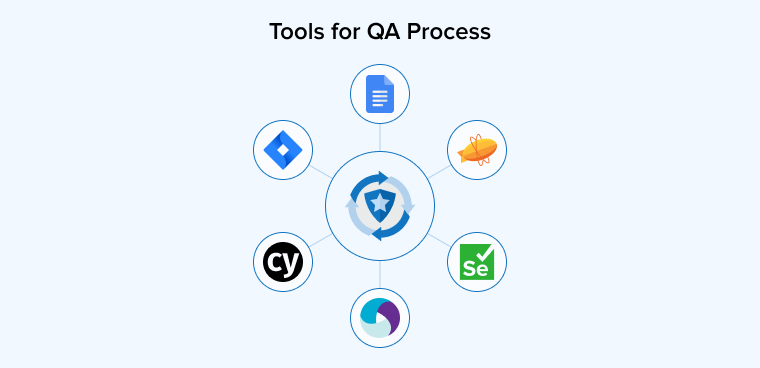
The correct tools are essential for any quality assurance team to thoroughly test software and catch any issues that end users may encounter in the live environment. To begin, let’s discuss the importance of actual device testing.
For any type of testing, QA teams need access to working prototypes. Putting a website or app out there for the public to use is impossible without first putting it through extensive testing under realistic user situations. Testing on actual devices is required regardless of whether the tests are performed manually or automatically.
If you don’t have access to state-of-the-art equipment in your own lab, cloud computing can supply the essential infrastructure. The solution also has to be scalable to accommodate teams of varying sizes without slowing them down or reducing the quality of their output.
With over two thousand supported browsers and devices, including the newest devices and the most recent versions of top browsers, each tester may conduct tests in parallel on all of them.
- There will be no delays or disruptions.
- Easy administration of teams with built-in tools for forming sub-teams, assigning licenses, and enforcing access controls.
Several more tools would be:
- Google Docs – Documentation for a task, like a test plan or a worksheet, may be kept on Google Docs, where it can be quickly accessed and shared by everyone involved.
- Jira – Jira is a helpful tool for managing projects, monitoring bugs, creating tickets, and delegating work.
- Zeplin – Zeplin is a helpful tool for exchanging and receiving designer-created documentation.
- Selenium – Website automation has never been easier than using Selenium.
- Cypress – Cypress is great for conducting automated tests on web applications.
- Appium – When it comes to automating app testing, nothing beats Appium.
Especially for a startup, putting together a quality assurance group might be difficult. Attempting this without a plan or framework in place will just make things more difficult.
Read More – Best Software Testing Tools
7. Benefits of a QA process
QA isn't an afterthought, it's a value-driven process designed to improve business outcomes.
— chi.bz (@chibuzorobilom) April 10, 2023
The right QA process yields:
– Increased customer satisfaction
– More secure systems
– Improved reliability
Invest in quality assurance to see ROI. #cc
Organizations that invest in quality assurance will reap several benefits. There are several upsides to implementing a quality assurance system.
7.1 Minimizing faults and mistakes
Companies may prevent errors and improve their goods, services, and processes by using stringent quality control procedures. Recalls, reworks, and customer complaints may be avoided along with the associated costs by catching and fixing problems before they reach consumers.
7.2 Boosting happy customers
Increasing customer satisfaction is the outcome of consistently providing products or services of a high enough quality to meet or surpass consumer standards. Customers who are happy with the services they receive are more likely to remain loyal to the company, offer constructive criticism, and promote its products or services to others.
7.3 Promoting continual development in companies
Organizations may pinpoint problem areas and take remedial measures through consistent monitoring and evaluation of performance. Having this frame of mind helps businesses remain competitive and fosters innovation by allowing them to respond to shifting client demands, market trends, and technology developments.
7.4 Improving output effectiveness
The production process is optimized to the point where it is effective. High-quality materials, few faults, well-operating machinery, adequate storage, and skilled labor are all part of this. Reduced time and material expenditures are hallmarks of effective production.
8. Conclusion
Throughout this insightful blog, we have showcased all the QA best practices involved in aligning a setup for the QA process. The bug fixes are a time-consuming process and thus, it needs a strategic plan to make a success. With the help of the development team and other team members, you will achieve desired testing results. The QA teams have to undergo this mature QA process to match the quality code and the test plan. Setting this up for your QA department will audit and ensure all the errors are handled first-handedly. You and your organization are all set to achieve comprehensive benefits of the QA process starting from scratch to end.


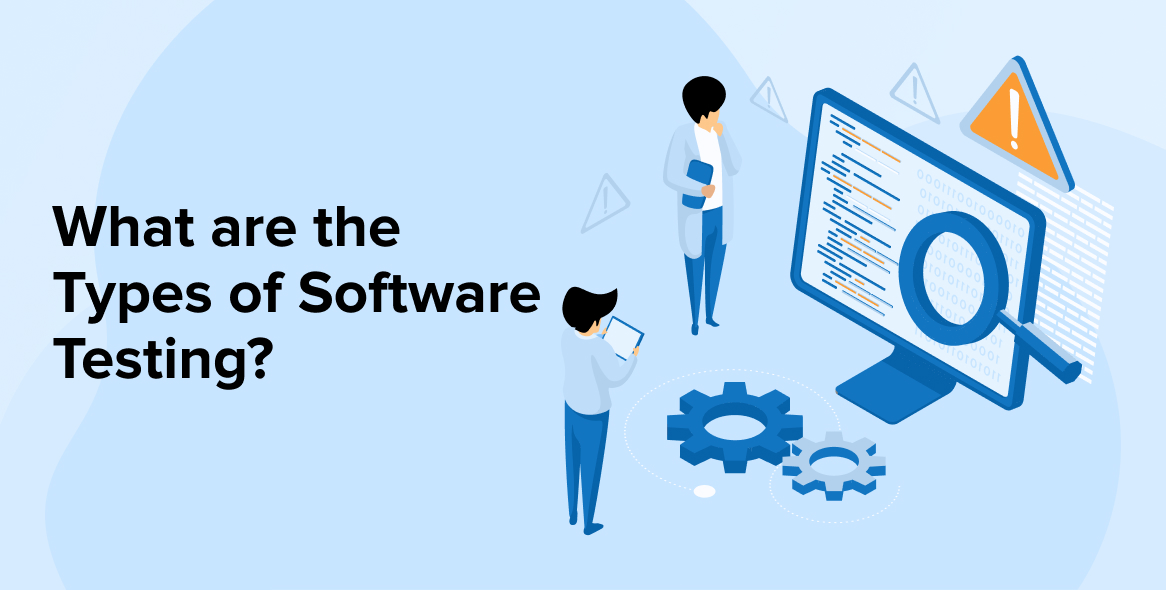

We all know that quality assurance is the most important part of software development. It ensures that the final product meets high-quality standards. I would like to recommended add tools and methodologies to this article. Because with the right tools and methodologies, QA teams easily identify bugs, and defects, identify all the issues, and address them.
I across many articles to learn how can I set up the QA process and finally I found this article. I really like this article because the explanation of this article is amazing. It's clear that a robust QA process is essential for producing high-quality software, reducing costs, and improving customer satisfaction.
I feel that the quality assurance process is essential for software development since I'm a tester. The highest quality standards are met, and the result satisfies client expectations, thanks to a properly implemented QA process. We can improve the product's quality and provide a smooth user experience by combining continuous testing and regular feedback from customers.
Excellent post on developing a QA process! It would be great to include some more detailed examples of QA tools and approaches. I would also suggest including information about the value of automation and continuous testing.